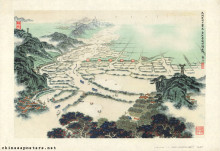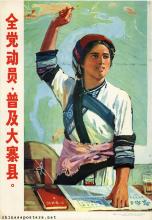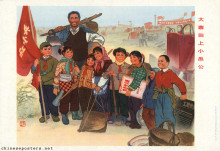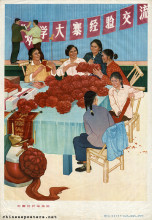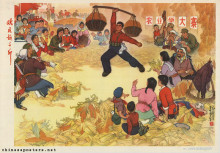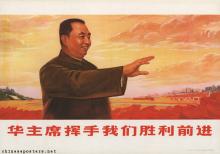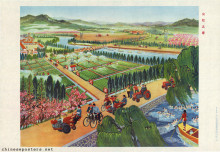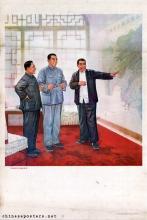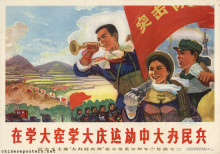The Dazhai Production Team in Xiyang County, Shanxi Province, was made into a national model in 1964 when Mao Zedong issued the call "In agriculture, learn from Dazhai" (农业学大寨). The essay "The Foolish Old Man Who Removed the Mountains"  , one of Mao’s "Three Constantly Read Articles" written in 1939, was seen as the theoretical basis for this emulation movement. Dazhai’s success story was based on its self-reliance in turning its infertile soil into productive land by relying on manpower and hard work. Water was transported over many miles for irrigation, land was cleared in the mountains, and terraced fields were built that withstood drought and flood. Dazhai (大寨) became an object of intense study.
, one of Mao’s "Three Constantly Read Articles" written in 1939, was seen as the theoretical basis for this emulation movement. Dazhai’s success story was based on its self-reliance in turning its infertile soil into productive land by relying on manpower and hard work. Water was transported over many miles for irrigation, land was cleared in the mountains, and terraced fields were built that withstood drought and flood. Dazhai (大寨) became an object of intense study.
The main driving force behind these achievements was Chen Yonggui, a true Party activist who represented the poor and lower-middle peasants of the team. Chen, usually shown with a towel around his head, organized the villagers into teams with names such as "Oldsters and Youngsters", and "Iron Girls", to perform the backbreaking work that was needed to convert barren Dazhai into a "Pacesetter in China’s Agriculture".
Great Struggle against Crooked Valleys and Rivers, 1974
In the early 1970s, Dazhai had become the benchmark for all agricultural production. The Dazhai example had to be followed everywhere, regardless of what the local conditions might be. Daily, some 20,000 visitors passed through Dazhai to study this model of self-reliance. Following Dazhai turned out to have disastrous consequences, in particular in areas with abundant water resources. Only by late 1980, the Dazhai model was officially discredited. It transpired then that Dazhai’s achievements were the result of the extensive assistance from the People’s Liberation Army. Moreover, heavy machinery had been used, whereas Dazhai had been propagated as a model that relied on pure manpower and a clear understanding of proletarian politics.
Mobilize the Party and agriculture in the struggle to promote Dazhai County, 1975
The influence of the Dazhai campaign proved tenacious. Even today, one can still see faded slogans proclaiming Nongye xue Dazhai (In agriculture, learn from Dazhai) in rural parts of China. By the late 1990s, Dazhai’s inhabitants no longer stressed self-reliance and hard work, but strove to become as well off as the rest of the people. Not a single household was solely engaged in agriculture anymore, and more than 80% of the villagers had found work in industry and the service sector, in particular tourism. Most of the arable land was turned into orchards and dense woods.
A project similar to Dazhai, also started during the Great Leap Forward campaign, was carried out in Maotian (毛田, also transcribed as Maotien), Yueyang County, Hunan Province. Here too, "mountains and rivers were reshaped by relying on the strength of the people’s communes" to create a model county. At the time, Hua Guofeng was the responsible Party official. Maotian was visited and praised by Mao. It did not, however, become as well-known as Dazhai. The four posters below are a variation on the traditional theme of the four seasons - spring, summer, autumn, winter.
"China’s Model Village: From Political Symbol to Brand Name", Xinhuanet  , 27 June 2002
, 27 June 2002
Tachai - Pacesetter in China’s Agriculture (Peking: Foreign Languages Press 1978)
Kwok-sing Li (editor) & Mary Lok (translator), A Glossary of Political Terms of the People’s Republic of China (Hong Kong: The Chinese University Press 1995)
Xin-An Lu, "Dazhai: Imagistic Rhetoric as a Cultural Instrument", American Communication Journal Vol. 5 No. 1, Fall 2001
Peter J. Seybolt, Throwing the Emperor from His Horse - Portrait of a Village Leader in China, 1923-1995 (Boulder: Westview Press, 1996)
Wen Yin & Liang Hua, Tachai - The Red Banner (Peking: Foreign Languages Press 1977)
Xiyang County "Geography of Dazhai" Writing and Editorial Group, Geography of Dazhai (Peking: Shangwu yinshuguan 1975) [in Chinese]
Jijun Zhao & Jan Woudstra, "‘In Agriculture, Learn from Dazhai’: Mao Zedong's revolutionary model village and the battle against nature", Landscape Research 32:2 (2007), 171-205 https://doi.org/10.1080/01426390701231564









